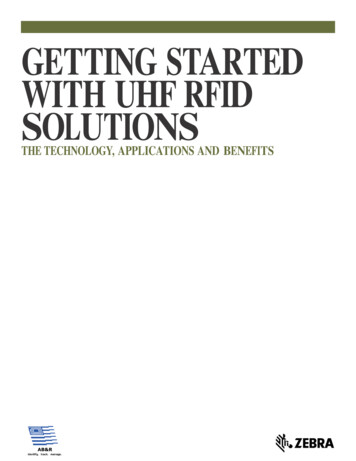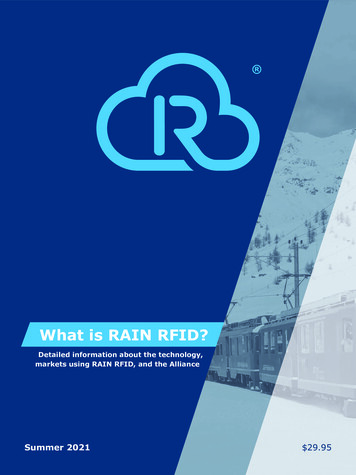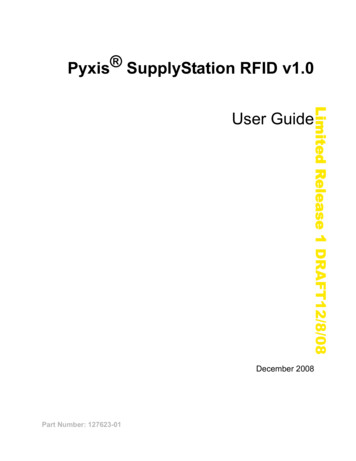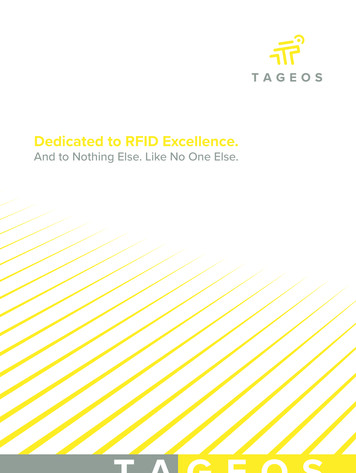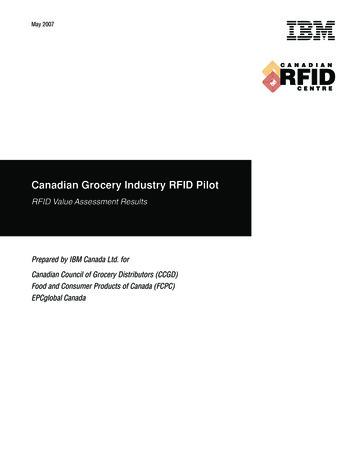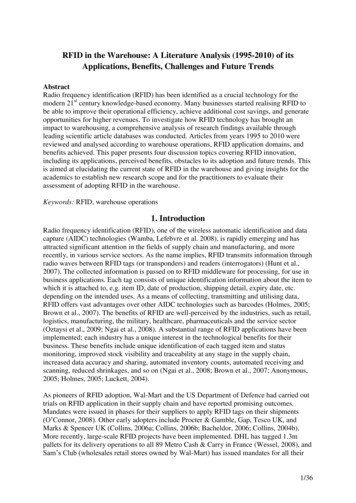
Transcription
RFID in the Warehouse: A Literature Analysis (1995-2010) of itsApplications, Benefits, Challenges and Future TrendsAbstractRadio frequency identification (RFID) has been identified as a crucial technology for themodern 21st century knowledge-based economy. Many businesses started realising RFID tobe able to improve their operational efficiency, achieve additional cost savings, and generateopportunities for higher revenues. To investigate how RFID technology has brought animpact to warehousing, a comprehensive analysis of research findings available throughleading scientific article databases was conducted. Articles from years 1995 to 2010 werereviewed and analysed according to warehouse operations, RFID application domains, andbenefits achieved. This paper presents four discussion topics covering RFID innovation,including its applications, perceived benefits, obstacles to its adoption and future trends. Thisis aimed at elucidating the current state of RFID in the warehouse and giving insights for theacademics to establish new research scope and for the practitioners to evaluate theirassessment of adopting RFID in the warehouse.Keywords: RFID, warehouse operations1. IntroductionRadio frequency identification (RFID), one of the wireless automatic identification and datacapture (AIDC) technologies (Wamba, Lefebvre et al. 2008), is rapidly emerging and hasattracted significant attention in the fields of supply chain and manufacturing, and morerecently, in various service sectors. As the name implies, RFID transmits information throughradio waves between RFID tags (or transponders) and readers (interrogators) (Hunt et al.,2007). The collected information is passed on to RFID middleware for processing, for use inbusiness applications. Each tag consists of unique identification information about the item towhich it is attached to, e.g. item ID, date of production, shipping detail, expiry date, etc.depending on the intended uses. As a means of collecting, transmitting and utilising data,RFID offers vast advantages over other AIDC technologies such as barcodes (Holmes, 2005;Brown et al., 2007). The benefits of RFID are well-perceived by the industries, such as retail,logistics, manufacturing, the military, healthcare, pharmaceuticals and the service sector(Oztaysi et al., 2009; Ngai et al., 2008). A substantial range of RFID applications have beenimplemented; each industry has a unique interest in the technological benefits for theirbusiness. These benefits include unique identification of each tagged item and statusmonitoring, improved stock visibility and traceability at any stage in the supply chain,increased data accuracy and sharing, automated inventory counts, automated receiving andscanning, reduced shrinkages, and so on (Ngai et al., 2008; Brown et al., 2007; Anonymous,2005; Holmes, 2005; Luckett, 2004).As pioneers of RFID adoption, Wal-Mart and the US Department of Defence had carried outtrials on RFID application in their supply chain and have reported promising outcomes.Mandates were issued in phases for their suppliers to apply RFID tags on their shipments(O’Connor, 2008). Other early adopters include Procter & Gamble, Gap, Tesco UK, andMarks & Spencer UK (Collins, 2006a; Collins, 2006b; Bacheldor, 2006; Collins, 2004b).More recently, large-scale RFID projects have been implemented. DHL has tagged 1.3mpallets for its delivery operations to all 89 Metro Cash & Carry in France (Wessel, 2008), andSam’s Club (wholesales retail stores owned by Wal-Mart) has issued mandates for all their1/36
suppliers to apply RFID tags in stages (Burnell, 2009). There is evidence showing an increaseof pilot trials and implementations over recent years (Roberti, 2006).Due to its well-perceived capability and popularity in the business world, RFID has alsogained a rapid growth of interest in the academic community across different disciplines.In order to ascertain the extend of RFID coverage in logistics literature, a preliminarybibliographic search was conducted using the ISI Web of Knowledge database. The ISI Webof Knowledge database is considered as a primary source for citation studies (Roth, 2005;Meho and Yang, 2007). Results of the query are illustrated in Figure 1, which shows theexponential growth of RFID publications from 1995 to 2010. The growing trend coincideswith the forecast put forward by Ngai et al. (2008) and Chao et al. (2007). It can be noted inFigure 1 that, since their review on RFID literature up to 2005, the number of publicationsfrom 2005 to 2010 has proliferated, indicating a need to review this new literature.Furthermore, as Figure 1 shows, the increasing number of RFID publications in the domainsof transport, logistics and supply chain follows the growing trend of overall RFID research.Conversely, the particular interest in RFID in warehousing is rather stagnant and relativelysmall in comparison to other research domains. Warehousing is a critical supply chainfunction and such outlook (in Figure 1) suggests a greater demand to review this underfocused domain comprehensively. This is corroborated by Curtin et al. (2007) stated thatamongst many domains in RFID research, warehousing comes as one of the key domains togreatly benefit from RFID adoption. Moreover, in the RFID literature warehouse applicationis mainly discussed as a subset. The relatively few publications focusing solely on RFIDapplication in the warehouse include the use of RFID case-based reasoning for managingdifferent warehouse operations (Poon et al., 2009; Chow et al., 2006), investment inimproving inventory accuracy (Uckun et al., 2008), RFID adoption issues andimplementation challenges in warehouses (Bahr and Lim, 2009), and an empirical study ofRFID in the warehouse industry evaluating its costs and benefits (Vijayaraman and Osyk,2006).[Insert Figure 1]This review of RFID research on warehousing aims to identify the gaps that have not beenexplored in previous works, in particular, with general or supply chain management scope. Inother words, the reader can learn what benefits and applications of RFID in warehouses arestrongly linked to identification and what associated benefits of RFID are seldom examinedin the warehousing literature. Also, the current status of RFID solutions for warehousing isevaluated against previous recommendations. Moreover, potential RFID obstacles and futuretrends are examined from the warehousing perspective.The above justifies the contribution of this paper to comprehensively review the academicliterature on RFID in warehouses, considering its application and influence on warehouseoperations. The research questions addressed in this work are: What is the state of RFIDapplication in warehousing as presented in academic literature and what are the perceivedbenefits? Are the RFID benefits interlinked and could this help academics and practitioners tobuild a stronger case for the technology adoption? In order to answer these questionsfollowing objectives were set: To develop a framework classifying RFID literature, focusing on its warehousing subsets To review and analyse the literature, within the classification framework, how RFID hasapplied and added values in the warehouse2/36
To examine the benefits of RFID in warehouse operations and rank them according totheir perceived gains To study the future trends to provide insights for academics to establish new researchdomains and for practitioners to examine associated benefits to prove for a business caseThis paper is organised as follows: Section 2 describes the methodology used in analysing theacademic literature and four discussion topics have been identified. Section 3 discusses topicone, which is the framework to analyse the literature based on RFID application domains. Itis then followed by Section 4 (topic two) using a benefits matrix to analyse the correlationbetween the benefits and warehouse operations and application domains for all the articlesstudied, so as to identify the popular and under-focused (but potentially value-added) benefitswhich could draw the attention of researchers and practitioners. Obstacles to RFID adoptionin the warehouse (topic three) are discussed in Section 5 and the future trends of using RFID(topic four) are analysed in Section 6. Finally, concluding remarks will be given in Section 7.2. MethodologyUp to 2010, there are two major literature reviews analysing the state of research on RFIDtechnology: Ngai, et al. (2008) and Chao et al. (2007). They presented the scientific literaturefrom 1991 to 2005 and 1995 to 2005 respectively. By means of bibliometric analysis, Chao etal. (2007) documented the number of publications per year, type, country and language anddivided the RFID literature into technological innovation, organisational adoption and time ofnew challenge and diffusion. On the contrary, the literature review by Ngai, et al. (2008) isbased on content-oriented classification and divided the literature into categories such asRFID applications, policies and security. The authors also provided a discursive analysis onthe future research directions.As discussed in previous section, there is a demand to conduct a comprehensive literaturereview of the current state of research related to RFID in warehouse operations, and ananalysis to explore the future trends of RFID in warehousing in order to identify the newresearch directions and value-added applications for the academics and practitioners. Incontrast to the general RFID literature reviews by Chao et al. (2007) and Ngai et al. (2008)this paper analyses the literature that pertains to the applications of RFID technologyspecifically in warehouse operations.2.1 Timeline of research literatureThis study explores the literature in consecutive years from 1995 to 2010. The choice of 1995as a start of literature search follows the reasoning from Ngai et al. (2008) and is also justifiedby the results of bibliographical query as shown in Figure 1.2.2 Literature searchThe academic literature reviewed in this study was obtained from the leading databases ofscholarly articles in order to review the field as comprehensively as possible. The scholardatabases used in this study are:1. ABI/Inform Complete2. ACM Digital Library3. EBSCO Business Source Complete4. SCOPUS5. Emerald6. IEEE Xplore3/36
7. Science Direct8. Springer Link9. Taylor & Francis2.3 Database queryDespite the differences in performing literature search between the databases, in each case thefollowing generic query was used: «(Title OR Abstract) CONTAINS ("radio frequencyidentification" OR rfid) AND (Title OR Abstract) CONTAINS (warehouse NOT "datawarehouse") AND (Timespan) 1995-2010 AND (Article Type) (Peer Reviewed)». It wasnecessary to exclude the phrase “data warehouse” as it does not refer to the warehouse in thesupply chain. The search query resulted in 403 articles. Articles with duplicate entries due todatabase overlap, news articles from trade magazines and articles in languages other thanEnglish were discarded. The process of categorising and analysing the remaining 253 articleswas modelled after practice outlined by Ngai et al. (2008), whereby two authorsautonomously analysed the articles and discrepancies between authors’ judgement werereconciled by discussion, with the input and agreement from the third author, until aunanimous decision was made whether to include article in the set. As a result, an additionalof 195 articles was rejected because they were matching the query but did not focus on RFIDresearch work in the warehouse (e.g. they only mentioned warehouse as an example for RFIDapplication but did not actually conduct research in the domain). This leaves 58 articles to beanalysed in this paper.2.4 LimitationsThis study is subject to a number of limitations. First of all, despite using 9 leading scholarlydatabases, there is a possibility of some scientific articles not being covered as they are notindexed in any of them. The second limitation is related to the characteristics of dynamicnature of online publication databases. As the articles become available from the publishers,some of them might have been added at a later stage and backdated. Therefore, the authors ofthis paper recognise that some articles may have not been included as they were not availableon the databases at the time of writing. The last limitation is that this study is only focused onarticles published in English language. Despite these limitations, it is believed that this studyhas achieved reliable comprehensiveness and can benefit academics and practitioners inestablishing new research directions and evaluating their assessment of applying RFID in thewarehouse.2.5 AnalysisMany academic literature reviews focus on bibliographical/statistical analysis that revolvesaround the categories, e.g. by type of journal, country, most cited institutions/individuals, etc.However, this study analyses the use of RFID technology in the warehouse, considering howand where it is applied to improve warehouse efficiency, what are the important benefitsgained and its future trends to provide insights for new research scope and value-addedbusiness applications. This study area has been identified by Ngai et al. (2008) and Chao etal. (2007) as the next movement for researchers focusing on business values andorganisational applications when the technology is reaching its maturity stage. Theframework developed in this research builds upon the theoretical foundations from thestrategy and information systems disciplines. These fields contributed significantly to theunderstanding of processes involved in the implementation of new technology, analysis ofchallenges to its adoption and benefits thereof (Whittaker et al., 2007; Dutta et al, 2007). Tofacilitate the analysis this paper is divided into four discussion topics as follows:4/36
Discussion one: The application domains of RFID in different warehouse operations willbe explored. Discussion two: A matrix will be produced to examine the benefits perceived. Discussion three: A discussion of the potential obstacles of adopting RFID in thewarehouse. Discussion four: An analysis of the future trends that could further benefit the use of RFIDin the warehouse.In order to help academic and practitioner readers to better comprehend the key findings ofthe literature reviewed in this article, an RFID framework was developed (see Figure 2). Itshows the application of the RFID in the warehouse, its benefits as well as theimplementation obstacles related to this technology. Its categories are based on the analysisof the literature reviewed and the foundation of warehouse research. The framework is alsoaimed for facilitating the aforementioned four discussions.[Insert Figure 2]Figure 2 shows that there are several factors to consider during RFID implementation in thewarehouse. The RFID technology can be implemented in all or only selected warehouseoperations and there are several application domains to choose from. Furthermore, the RFIDbenefits and implementation obstacles can also be identified at first glance. The frameworkpresented in Figure 2 could be a good reference for both academics and practitioners duringtheir work on implementing RFID in the warehouse.3. Discussion One: Application of RFID in the Warehouse3.1 Warehousing operations and their importance in the supply chainThe efficiency and effectiveness of the supply chain network is depending on theperformance of its functional elements, in particular, warehousing operations (Rouwenhorstet al., 2000). They facilitate storage and buffer functions between upstream and downstreampoints of the supply chain (de Koster, Le-Duc et al. 2007). The core warehouse operationsrevolve around the flow of materials in the facility, which are receiving, put away, storage,order picking and despatching (Gu et al., 2007, Berg and Zijm 1999). Receiving is the start ofthe warehousing process, in which the arriving items are unloaded from the transport carriers.Their identity, quantity and condition is checked at this stage, and items may be repacked todifferent stock keeping units, i.e. put into stillages, palletised or de-paletised, after which theyawait for the next process called put away. Put away is the process of physical moving of thereceived goods from the staging area to the locations in the warehouse, where they can bestored. Storage is the placement of goods in the facility for the purpose of safe keeping,protection and retrieval as required by the next activity. Order fulfilment or order pickingrefers to the removal of items from the storage locations for the purpose of fulfilling customerorders. Completed orders are checked to ensure picking accuracy and may be sorted orconsolidated before despatching. Consolidation refers to grouping multiple orders for thesame destination. Despatching is the last warehousing activity, in which goods are loadedonto the transport carrier. In addition to the aforementioned activities, warehouses also offercross-docking function that coordinates products movement between receiving anddespatching activities. Inbound cargo is sorted, combined with other inbound deliveries anddespatched without being put to storage. Cross-docking operations serve the purpose ofholding fewer inventory, reducing storage costs and improving service times (Maknoon et al.,5/36
2009). Furthermore, warehouses may also perform a range of value-added processes, such asbreak-bulk, unpacking, testing, assembling, labelling and repacking.Warehouse operations are critical in the supply chain management context (Lambert et al.1998; de Koster, Le-Duc et al. 2007). Through their operations they address changing marketconditions, and uncertainties of production and demand fluctuations. Moreover, they arecapable of taking advantage of transportation and production economies, as well as allowingbulk quantity purchases to reduce procurement costs. Warehouses also serve as a buffer foractivities like cross-docking, direct deliveries as well as reverse logistics whereby materialsare collected for disposal or recycling. Additionally, warehouses create important linkbetween suppliers and customers by overcoming space and time distance between them,allowing for maintaining desired customer service levels, consolidating multiple orders intoone delivery and supporting just-in-time agreements between suppliers and customers.3.2 RFID literature analysisThis paper performs an analysis on RFID publications corresponding to their application ofthe technology in the warehouse, which was a basis for the classifying framework. In the firststep of this classification, based on the content of the articles two categories were formed:conceptual and implementation-focused application. The distinction between them is basedon how the authors applied their research and findings. Articles demonstrating RFIDapplication in warehouse environment at a company or laboratory facility were classified as“implementation-focused application”. Whereas articles based on the results of softwaresimulation, theory or proof of concepts, which did not state unambiguously about anyapplication or test in a warehouse were put to “conceptual” category. There are 16 articlesidentified as implementation-focused applications and 42 articles that belong to conceptualcategory. This in itself highlights the lack of implementation-focused applications and thegap forming between these two categories.By thoroughly analysing the articles, they were further grouped by their application domainand warehouse operation; some of them belong to more than one category (see Table 1). Asdepicted in Table 1, seven application domains were identified and in addition to the fivetypical warehouse operations a category “others” was included for articles of which the focusis on the general use of the technology in the warehouse. The 58 articles were then mappedwith the appropriate RFID application domains and warehouse operations. To distinctbetween implementation-focused application and conceptual articles in each applicationdomain, Figure 3 is produced. It can be noted that the domain of inventory/storagemanagement has received the most attention whereby 24 articles have been published (17being conceptual articles and 7 implementation-focused applications). The sequence of orderis then followed by RFID system configuration (15 articles), MHE management (10 articles),WMS (9 articles), picker routing (8 articles), order management (6 articles), and lastly, layoutwith only 1 article. Table 1 can be further analysed with Figure 4 showing the number ofresearch works in each warehouse operation. It can be seen in Figure 4 that most works (22articles each) are related to receiving and storage operation, which coincide with Figure 3whereby the biggest RFID application domain is inventory/storage management. Thefollowing subsections analyse the conceptual and implementation-focused categories basedon RFID application domains.[Insert Table 1][Insert Figure 3]6/36
[Insert Figure 4]3.3 Inventory/storage managementAccording to Figure 3, the majority of authors focus on the use of RFID in inventory/storagemanagement, which is the inherent part of core warehouse operation. It can be seen that thenumber of conceptual articles overgrow implementation-focused articles. The literaturestudied shows how RFID systems can benefit the warehouse in inventory and storagemanagement, especially in the effort to resolve inefficiencies such as poor storage spaceutilisation, misplaced stocks, and wrong inventory records.The conceptual articles present ideas or methods, some with supported simulation results, toenvisage how RFID can be used in the warehouse. For instance, Ho et al. (2008) proposed anoptimal methodology to solve the problem in relation to storage location assignment and usedRFID to facilitate storage in a random and fragmented manner (i.e. enhancing the use andtaking advantage of the benefits of employing random storage policy), and Hariharan et al.(2009) proposed Partially Observable Markov Decision Process model to enable quickdetection of misplaced items in the warehouse using portable RFID devices or RFID-enabledforklift trucks. This helps to avoid wrong storage that leads to inventory inaccuracy,incomplete orders and subsequently, lost sales. Prior to implementation, it is common to usesimulation software to evaluate new ideas. Rizzi et al. (2008) and Lu et al, (2007) usedsimulation approaches to redesign and test warehouse processes of a FMCG company andpallet movement systems respectively. Whereas Wang et al. (2008) and Wang et al. (2009)analysed processes at the mail and vegetable distribution centres respectively, pointing outhow the introduction of RFID will impact the operations in these facilities.As the technology advances, applications have been found incorporating RFID with othertechnologies/systems, on both software and hardware aspects. Software applications include amulti agent system used in the warehouse for controlling inventory and communicating withsuppliers (García et al., 2007), rule based autonomous storage planning (Cheung et al., 2009),an RFID-based fuzzy storage assignment system (Ho et al., 2010) and a case based reasoning(Lao et al., 2010). The hardware aspect of RFID applications includes an unique method ofmaterial tracking (using RFID and IR) in the warehouse proposed by NEC (Naohisa et al.,2006). Other examples include Wang et al. (2010b) combining RFID with a novel design ofconveyor belt system for storage and picking of items to fulfil customer orders and enablesenhanced storage utilisation and Chuan et al. (2007) proposing a warehouse robot that usesRFID to identify objects and places in the warehouse by reading their tags and is able tonavigate to designated locations. Furthermore, there are other creative proof of conceptmodels, such as unmanned air vehicle (UAV) flying in the warehouse aisles for stock taking(Ong et al. 2007), RFID-enabled hand glove for locating lost items and counting inventory(Muguira et al., 2009) and tracking frequent walks of warehouse operatives or retailcustomers to reveal frequently visited spots in the facility (Berenyi et al. 2008).The research work in implementation-focused articles involved developing a system for usein business applications. For instance, Wang et al. (2010a) developed Digital WarehouseManagement System (DWMS), which consists of RFID-embedded pallets and shelves, toprovide real-time visualised inventory control and automatic storage and retrieval. Liu et al.(2006) developed a resource management system to select the most suitable MHE to performloading/unloading tasks in a lab-based warehouse facility. Since its introduction to the7/36
logistics field, RFID was considered as a promising technology that could improve operationsnot only within a company, but as a wider system connecting businesses. A number ofimplementation-focused articles presented such business-to-business (B2B) e-commerce withsharing RFID-collected inventory data. Bendavid et al. (2006) built a proof of concept modelin the laboratory demonstrating inventory data collection from the process of despatchingcargo to receiving at distribution centre. Other authors were also using similar B2B approachfor inventory management in their respective supply chains, such as in beverage industry(Wamba et al. 2006), textile industry (Kwok and Wu 2009), and agricultural industry(Gandino et al. 2007; Zeimpekis et al., 2010).3.4 RFID system configurationSeveral studies were conducted to evaluate the configuration of RFID system in thewarehouse, which resulted in the propositions of system set up. All articles studied arebelonging to conceptual category, mainly focusing on testing their developing models to findthe best system configuration and hopefully can be applied in implementation-focused. Ageneral description of RFID system set up for warehouse consisting of tags, readers,middleware and WMS was provided by Li et al. (2009) and Modrak et al. (2010). The systemconfiguration can be tuned depending on the specific requirements. For example, Choy(2009) presented a mathematical model for reconfiguring RFID systems, which takes intoaccount of warehouse policies at pallet, case and combined levels. With this model decisionscan be made regarding the hardware requirements for the RFID to be used in differentwarehouse applications. A variety of possible configurations is considered by Ross et al.(2009) whereby six scenarios were analysed and simulated, from barcode only to full RFIDroll-out. The factors considered are labour utilisation, personnel and warehouse activity costs.While considering implementation strategies, it is important to reflect on the problemsemerging during RFID roll-out at the warehouse. There are several factors influencing thefeasibility of RFID system in warehouse operations that were tested by Porter et al. (2004),which included capture zone, orientation requirements, performance with MHE, performancewhen attached to different containers and content.Another problem for RFID set up in the warehouse is regard to the entire facility coveragewithin the reader’s range. A solution was proposed by Reza and Geok (2009) who developedsquare and hexagonal grids that ensure adequate coverage of desired areas with appropriateRFID signal. Similar radio waves propagation within facility was also undertaken byBosselmann and Rembold (2006) whereby a ray tracing model was developed to visuallyshow the areas where RFID signal was weak, so that tuning to ensure full coverage can bedone. In order to be able to provide the functionality of RFID system despite incompletereadings, Hoong (2008) designed an experiment to find the least possible area for obtaining afull read rate of stacked cartons and this can be proved useful in setting up antennaspositioning and tags reading. Likewise, the study on tagged carton containing metal andwater moving on conveyor belt was conducted by Kabadurmus et al. (2007) and it was foundthat product type is a major factor contributing to RFID tag readability and fast conveyorspeed being the second reason for tag misreading. This finding coincides with the study bySingh et al. (2008) and Singh et al., (2009) on palletised consumer goods, such as paper rolls,soda cans and water bottles. The variables identified were product type, pallet stackingpattern and forklift truck speed. Another factor impeding tag readability is the proximity ofreaders in a dense warehouse environment (Leong et al. 2006). A possible solution to thisissue is proposed by Anssens et al., (2010) suggesting to synchronise readers’ beam.8/36
3.5 WMSThere are considerable interests in investigating how RFID influences WMS and the effectivemethods of integration between them. Figure 3 shows 8 conceptual articles and oneimplementation-focused application article related to RFID-assisted WMS. Generally, WMSand RFID technology are integrated at three levels: data collection, data movement and datamanagement (Tan, 2008). Data collection is realised by RFID readers communicating withWMS via IT network, and is analysed and used by WMS as part of data management.However, continuous stream of data in regard to identification and location of tags puts astrain of WMS causing long processing times. In order to alleviate this issue, at conceptuallevel Yang and Zou (2005) proposed an event-driven RFID reader management whereby datais sent to WMS on event triggered basis. This means that readers are only activated in theoccurrence of detecting stock movements, and hence, only meaningful data is sent to WMS.In addition, WMS may not be readily able to communicate with RFID system, thus it isnecessary to add an additional software layer that will enable data exchange. Chu et al.(2008) proposed a way to integrate RFID middleware with WMS based on service-orientedarchitecture (SOA), converting RFID data to
greatly benefit from RFID adoption. Moreover, in the RFID literature warehouse application is mainly discussed as a subset. The relatively few publications focusing solely on RFID application in the warehouse include the use of RFID case-based reasoning for managing different warehouse operations (Poon et al., 2009; Chow et al., 2006 .





